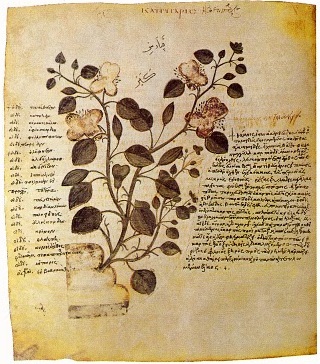The earliest surviving records of illustrated Greek Herbals indicate De Materia Medica was widely read and reproduced during Middle ages in Latin, Arabic and Greek. For 1500 years was the standard authority both in botany and materia medica, assuming considerable significance in the development of both Western and Islamic cultures.
De Materia Medica now is partially based on the lost work of Diokles, also called Hippocrates II, which dealt with hygiene and prophylaxis, and gave detailed instructions for a healthy living. The earliest copies of Dioscorides Manuscript were not illustrated. The oldest fragment survived is the Michigan Papyrus. The finest surviving comprehensive manuscript copy, magnificently illustrated, was made in the sixth century in Constantinople - Codex Vindobonensis. The manuscript is on vellum, written in Greek uncials in the tradition of early 6th century calligraphy. Alternate plant names in many languages were probably added by the Alexandrian lexicographer Pamphilos in 1st century AC, and they are provided in African, Andreae medici, Armenian, Egyptian, Bessicum, Boeotian, Cappadocian, Dacian, Dardana, Democriti, Ethiopian, Gaulish, Spanish, Istrici, Lucanica, Marsum, Osthanis, Prophetae, Pythagorean, Roman, Tuscan and Zoroastrian. The coloured paintings of plants date from the second century, they are splendid and reveal a naturalism alien to Byzantine art of the time. Eleven items are clearly derived from the writings and paintings of Krateuas (Cratevas), physician to Mithridates VI Eupator, king of Pontus (120-60 BC). Codex Vindobonensis is a large book, roughly 30 centimeters square, of 491 parchment sheets, with nearly 400 full page paintings of plants and some smaller ones of birds. Many of them are indigenous to Greece and the Eastern Mediterranean area, or cultivated as edible crops. The first pages of Codex Vindobonensis have smaller paintings, including one showing Dioscorides at work while Intelligence hold a mandrake fro Krateuas to draw.
Some paintings are quite skillful, handling awkward details like the leaf-bases clasp the stem, fine leaved plants like fennel are well drawn, other beautiful illustration include cyclamen, wormwood, delphinium, scarlet pimpernel and asphodel. In this codex an alphabetic extract of the original text is given.
Nearly nine centuries pass before we hear next of the manuscript. It was rebound in 1406 by John Chirtasmenos for Natanael, a monk and physician in Podromos Monastery in Constantinople. After the Muslim conquest in 1453 the manuscript fell to Turks. A century later a Jew called Hamon, body physician to Suleiman the Magnificent, owned it. After few years the manuscript found its way to Maximillian II, into the Imperial Library in Vienna (now the Bibliothek Nationale). Some copies are found in Bibliotheca Nationale in Naples (Codex Neapolitanus), Cambridge, Paris, Florence and the Vatican. A rich illustrated Arabic Manuscript from 1224 is found in Top Kapu Saray Museum, some copies are also founded in Middle East museums.
Book one - Plants described: aromatics, 188 plants -
Book two - Discussion both of living creatures and of honey and of milk and of animal fat and of those things which they call frumentacea [cereals], as well as pot herbs [vegetables], annexing for those such herbs as are endowed with a sharp quality because such are near of kin, as are garlic and onions and mustard seed that the qualities of those things so similar in nature should not be separated.
Book three - An account of roots, juices, herbs, and seeds -- suitable both for common use and for medications.
Book four - About herbs and roots not previously mentioned.
Book five - About wines and metallic things, beginning with the tract concerning the vine.







No comments:
Post a Comment